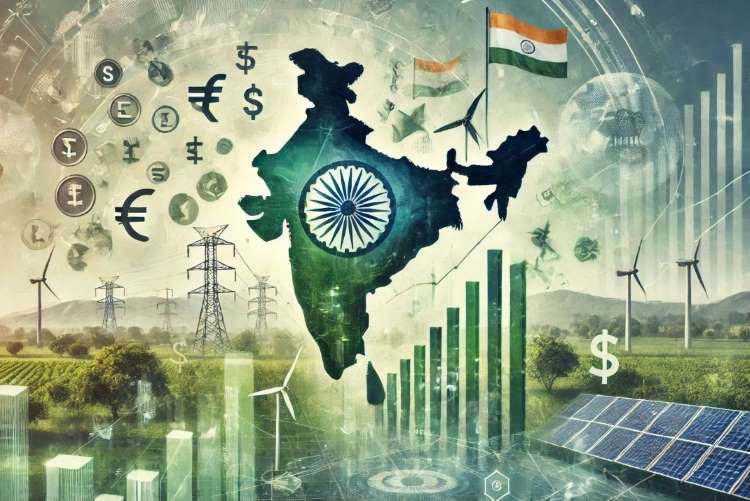
India faces a daunting task in raising climate finance through domestic resources, foreign investment and international support.
The climate finance crisis in India: Greenhouse gases are rising, leading to an increase in surface temperatures, and continued economic and biodiversity loss. The last decade, 2011-2020, was the warmest on record, with the decade since the 1980s warmer than the previous one. The Intergovernmental Panel on Climate Change estimates that the average global temperature has increased by 0.85 °C between 1880 and 2012, with an estimated increase of 1.5 °C compared to pre-industrial levels in 2040.
India, as the most populous country, plays an important role in the global climate process. Its efforts are important for reducing emissions and improving the local environment. Addressing climate change is critical for India to combat extreme weather events and reduce losses. Exposure to high temperatures and reduced working hours have led to significant loss of income in services, manufacturing, agriculture and construction in India, amounting to 5.4% of GDP by 2021. Moreover, India is among the most vulnerable countries of climate change faces some of the highest levels of risk worldwide, ranked 29 out of 191 countries (Inform Risk Index, 2019), with 80% of the population living in districts that are at high risk of severe hydro-meteorological disasters (floods, droughts, hurricanes).
Climate change, with its impact on various industries, has also increased risks to financial stability. Physical and transition risks from weather events reduce a borrower’s ability to service or repay a loan, becoming a credit risk for banks. This presents a highly vulnerable situation, considering that India is considered to be the most vulnerable to climate-related physical hazards among the BRICS countries and major economies (AEs). it is the IMF.
READ I FDI Policy: Accounts for India’s Economic Transformation
The need for climate finance
Solving climate change costs a lot of money. Green finance needs in India are estimated to be at least 2.5% of GDP per year to address the service gap caused by weather events. India’s current investment in clean energy stands at $17 billion by 2022. However, an estimated $50-100 billion per year of incremental investment is needed. These costs will include the cost of building the infrastructure for the green transition of electricity, industry and transportation, estimated at more than $10.1 trillion, with a deficit of $3.5 trillion over known sources of income. In addition, reducing dependence on fossil fuels to meet climate goals will lead to significant financial losses, increasing the burden on the treasury.
Fuels – coal, oil and gas – together account for about 19% of the total revenue earned by the Union government. Also, the standard thermal aging vessels are smaller in developing countries compared to developed countries, which can result in higher stranded costs. As India reduces its reliance on fossil fuels in its energy mix, tax revenue from these sources will decrease. As a result, India will need more money to transition to green alternatives.
The relationship between climate and the economy

Lack of resources needs to be mobilized internationally and domestically. India faces a funding gap for its ambitious climate goals, despite strong arguments for aid. With historically low emissions (only 4% of global emissions between 1850 and 2019) and high levels of climate change (CCPI 2023), India qualifies as a top candidate for international aid. developed and international organizations to achieve its lofty goal of zero emissions. in 2070.
The principle of “common but differentiated responsibility” emphasizes the obligation of developed countries, with historically high emissions, to provide financial assistance. Access to these grants, along with local efforts, is critical to India’s sustainable future. Therefore, India must strengthen its efforts to secure subsidies based on low emissions and energy efficiency. India has asked developed countries to provide at least $1 trillion a year from 2025, made up mainly of grants and concessional funds.
Without adequate aid, international lending becomes an alternative for climate change financing. However, relying solely on foreign currency can undermine the balance of payments, affecting the current account deficit. This isolation creates risks, including exposure to events such as rising global interest rates, which could disrupt economic stability, affect exchange rates, sovereign values, and domestic monetary policy. .
In addition, the burden of servicing foreign debt diverts resources from domestic priorities in the future. To achieve climate goals, India needs a more sustainable approach. This includes mobilizing domestic resources, attracting foreign investment that promotes green technology, and seeking multilateral support through low-cost loans and technical assistance. By diversifying its financial resources, India can chart a more sustainable path to a sustainable future.
While using domestic savings is the easiest way to finance the green transition, India, being a developing country, needs to prioritize growth and development. Diverting local savings to green transition projects reduces the money available for infrastructure and other public sector priorities. Therefore, the government must focus on raising domestic revenue to strengthen the funds available for climate protection.
Moreover, domestic resource mobilization in India poses challenges due to bond market access and volatility in the foreign sector. India’s corporate bond market, which accounts for 16% of GDP, compared to Korea’s is over 80%. Similarly, China and Malaysia maintain much higher levels of corporate debt as a percentage of GDP compared to India. As a result, expansion of the total amount of household storage is necessary. The following are strategies by which India can enhance local resource availability to support green transition projects.
Increasing household financial capacity
Fintech involves saving money: By empowering more people to save and participate in finance, fintech can unlock valuable national savings to support India’s green future. Mobile banking and wallets bring millions into the financial system, showing a rise in the rate of financial inclusion from 25% in 2008 to 80% of adults in 2023. payments can encourage save by reducing transaction fees and maintaining a hassle-free experience.
To increase government revenue: To improve financial capacity to deal with climate change, India can increase the efficiency of saving money by disposing of non-essential goods, reducing unproductive spending like free, and improving financial performance. This approach aims to reduce the financial deficit, which is important for strengthening local savings and reducing government borrowing. For example, in 2022-23, 59 loss-making enterprises reported a combined loss of R4,811.73 crore, highlighting the potential for reallocation of resources. Such measures pave the way for issuing green bonds, which are important for financing sustainable projects and achieving environmental goals effectively.
Pension changes: Pension reforms in India have the potential to significantly increase national savings and unlock critical resources for addressing climate change. Despite increasing enrollment, the system needs deep penetration, especially among informal sector workers. The reforms could include informal savings such as chit funds in managed pension schemes such as the National Pension System (NPS), which would enable greater savings. In addition, increasing tax credits specifically for pension contributions can encourage people to save more. In addition, the NPS itself can be reformed to provide greater investment autonomy and a “clean technology sector” with higher returns focused on sustainable projects.
Consumption tax: Leveraging consumption tax reforms for climate action in India, is important in two ways. First, simplify the tax system and reduce the overall tax burden to increase savings. Second, implement higher consumption taxes on products that produce carbon, are harmful to the environment, and destroy goods like cigarettes. This discourages their use, promotes green alternatives, and raises money for climate projects. Carbon recycling can support climate change. A key step is to raise India’s carbon tax, which is currently one of the lowest in the world at $1.6 per ton of CO2, to achieve the target 33-35% reduction in emissions by enabling jobs polluters become more expensive and encourage cleaner alternatives.
The rush of green finance highlights the need for sustainable energy and infrastructure. International support, including grants and concessional funds, is essential to balance financing needs and reduce debt risks. A sustainable, diversified fiscal policy will help India meet its climate goals while sustaining economic growth. Through concerted efforts and strategic planning, India can lead the way to a sustainable future, addressing both immediate needs and long-term environmental commitments.

Dr. Badri Narayanan Gopalakrishnan is Principal Advisor and Head, Business and Entrepreneurship, NITI Aayog. Opinions expressed are personal.
#Climate #finance #perfect #storm #problems #India #Strategic #Circle